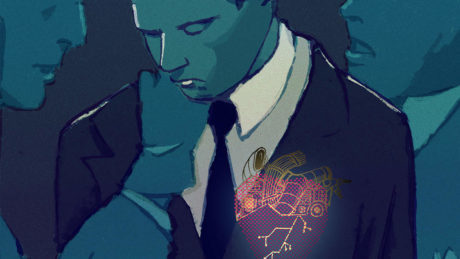Dial R for Robot is a mash-up of Hitchcock’s film Rope and the film Blade Runner, with some references to Hitchcock’s spy thriller Torn Curtain. The funk-rock opera is an immersive multi-media sci-fi experience. The show provides the audience intriguing food for thought by challenging our morality in context the laws of robotics and the depth of robotic intelligence. Specifically, the characters explore a robot’s capacity for distinguishing between fantasy and reality and its ability to commit violence.
Translating Hitchcock into a sci-fi rock opera is a bold and ambitious move. The cast, band, and Director (Chris Griffin) did an amazing job under the circumstances of sound difficulties and an abridged script. From what I could hear, the plot had some fun moments. For example, there is a point when they play video games on an Atari Console (retro video-gaming), which was an amusing throwback, especially in our new Pokémon Go world.
There were a few standout songs because I greatly enjoyed the wit behind the lyrics. These standout songs were: “How To Vanish in 39 Steps,” “Digital Love,” and “The UnCanny Valley.” As a rock opera, the show is 100% sung by the performers, except during transitions, or silent interaction with the projections. After the show, I spoke to the Playwright, Christian Crowley (who was also in the Android Band) about the songs. He mentioned that each song title is a Hitchcock reference, which is very clever. Many of the projection images were also an homage to Hitchcock films, so I think Hitchcock fans will likely appreciate this show.
The song “How To Vanish in 39 Steps” was my favorite because I could hear Buster Britches (portraying humanoid robot CJ) clearly, his singing was superb, and he brought his humanoid robotic character to life (bad pun intended). Other standout singers included Katharina Acosta (portraying Prof. Lee Sajou) and Caz Gardiner (portraying Harper Grace). Both had stunning and captivating voices.
I really wish that Lansing O’Leary’s (portraying Decker Shaw) and David Weiner’s (portraying Tyrell Byerly) microphones were working. They both made a valiant effort projecting their voices, but the Atlas Theater is a big venue to fill. I could tell they had amazing singing pipes; I just wish I could hear everything they sang. They both had a lot of songs.
The microphones for other performers were also not working. Overall, there were apparent sound issues throughout the performance, which inevitably overpowered the singing. As a result, I kept losing track of the story-line. By the end of the performance, I only had a vague understanding of the show as a whole. The show did run shorter than expected. It is Fringe and the show must go on, but I hope they are able to add some of it back in to maybe help clear up any potential confusion. But fixing the sound will definitely help with that particular issue.
The projected videos and images were by far the best part of the show! It was a magnificent advantage to have the Atlas Theater for this aspect of the performance. The projections were a team effort by Griffin (Co-created the video projections and was in charge of running them during the performance, Crowley (Co-creator of projections), Rob Parrish (Filmed the videos), and Mark Casale (who edited the videos)). The projections greatly engaged the audience, they were well-timed, smart, top notch quality, and the epitome of what makes sci-fi spectacular. I truly admire when multi-media works to enhance a show. The projections acted as part of the scenery and aided transitions beautifully. They also interacted with the plot, characters, and even the audience, but not in a distracting way because they were so key to the show.
I do not want to delve into the projections in too much detail, because I hate giving spoilers. However, I will say that in one cool part, the audience gets the opportunity to vote via Twitter which characters certain actors get to perform for a portion of the show. It was like a secret agent game, which was entertaining. I was impressed that the lyrics were customized based on the results and that the cast was prepared to perform multiple roles. I wish the timing allotted for voting was a bit longer. Perhaps my phone is slow, but I did not even have time to open Twitter before the next voting screen appeared.
The make-up and costumes (Yiwen Feng) were stellar. I liked the sci-fi – film noir vibe throughout the show. I particularly enjoyed how the Android Band was in costume and make-up. It was as if they were also characters. They sounded great. The band featured members from the world-groove jazz band Djesben (Katy Gaughan acting as conductor and playing the Bougarabou Drum and Cajón Drum; Topher Dunne playing the Chapman Stick and synths; Jerry Tolk playing the HandSonic; and Crowley playing the Electric Dulcimer). Gaughan had her shining moment when she coordinated the audience to clap in a particular rhythm, changing the speeds and her movements as she adjusted the style of clapping. I think the audience greatly enjoyed this interaction.
This show has immense potential. If the Dial R for Robot team can work out some of the glitches (sorry another bad pun); sci-fi, Hitchcock, and funk-rock music fans will have a fantastic show to look forward to during the 2016 Capital Fringe Festival.
Running Time: About 45 minutes, with no intermission.
Dial R for Robot is playing through July 23 at Atlas Performing Arts Center: Sprenger (1333 H St. NE) in Washington, DC. For tickets, call (866) 811-4111, or purchase them online.
LINK:
Check other reviews and show previews on DCMetroTheaterArts’ 2016 Capital Fringe Page.
RATING:






